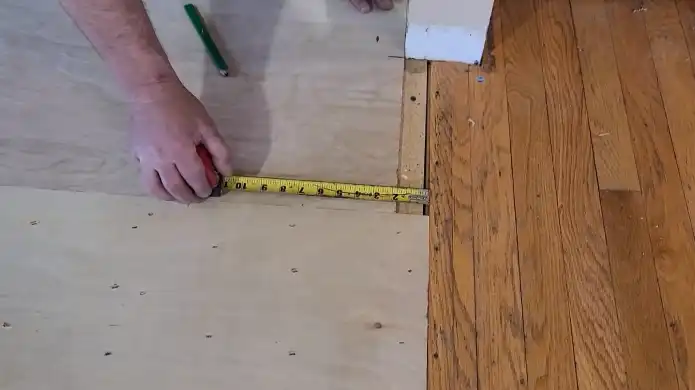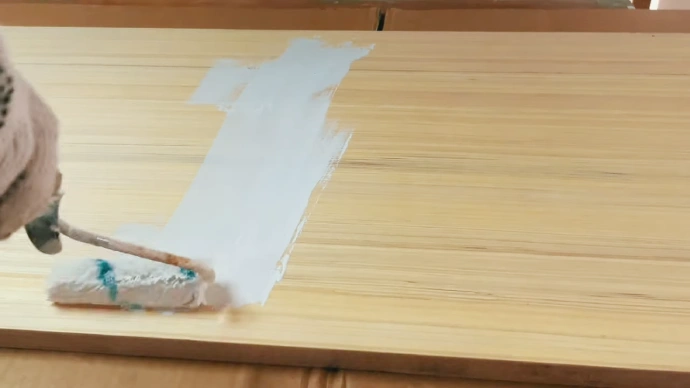How to Clean Blood off Hardwood Floors: 3 Methods [DIY]
Blood stains from a small cut or a more significant injury can be unsightly on hardwood floors. With the right techniques and cleaning agents, you can clean hardwood floors.
For unfinished hardwood floors, the cleaning steps involve blotting the blood, using baking soda, and thorough cleaning and drying. Waxed hardwood floors require blotting, using a detergent solution, wiping with a cloth, applying liquid wax, and polishing.
Polyurethane-finished hardwood floors can be cleaned by wiping with a damp sponge and refinishing them if necessary. Throughout this article, we’ll discuss how to remove blood stains from hardwood floors so that you can restore them to their former glory.
How to Clean Blood Off Hardwood Floors? Different Ways Based on Floors
Method #1 For Unfinished Hardwood Floors
Method #2 For Waxed Hardwood Floors
Method #3 For Polyurethane Finished Hardwood Floors
There are effective ways to clean it off, and it all depends on the finish of your floor. Let’s dive into the different methods to handle this unfortunate situation.
Method #1 For Unfinished Hardwood Floors
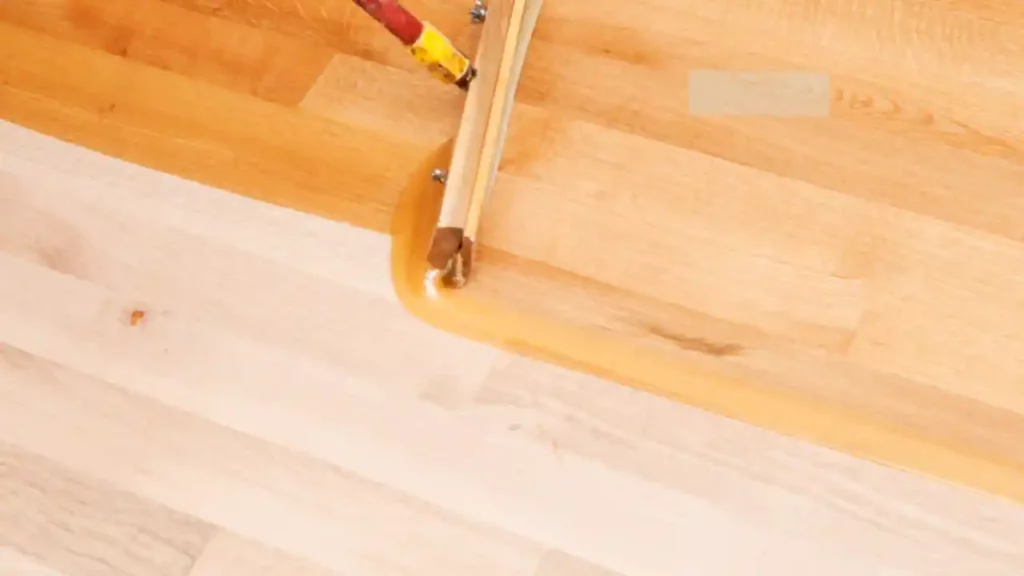
If your unfinished hardwood floors look worse for blood stains, follow these simple steps to clean them up:
STEP 1. Blot the Excess Blood:
You’ll want to grab a dry cloth or paper towel and gently blot the affected area to avoid spreading the stain. Remember not to rub, just blot. Rubbing can cause the blood stain to spread or go deeper into the hardwood floor.
Use a light touch and change the cloth or paper towel frequently to prevent the blood from soaking back into the floor. Move on to the next step once you’ve blotted up as much of the blood spills as possible.
STEP 2. Sprinkle the Affected Area With Baking Soda:
Spread some baking soda over the bloodstain to absorb excess moisture and freshen up the floor. Be sure to cover the entire affected area with a light layer of baking soda, and let it sit for at least 10-15 minutes.
This will give the baking soda enough time to absorb the blood and other liquids, making it easier to clean up.
STEP 3. Scrub the Area:
To remove the stubborn blood stain effectively, take a soft-bristle brush soaked in white vinegar and gently scrub the affected area. Make sure to use circular motions for optimal results.
This step is crucial in loosening the stain and removing any residue left on the surface. Once you’ve scrubbed the area thoroughly, you can move on to wiping the area clean.
STEP 4. Wipe the Area Thoroughly:
Wipe the affected area thoroughly with a dry cloth after scrubbing with white vinegar for the best results in removing stubborn blood stains. Use a clean, dry cloth to remove excess moisture and residue from the vinegar solution.
STEP 5. Rinse and Dry Hardwood Floor
Now you’ll need to give your hardwood floors a refreshing shower with cool water. It’s like dipping in a mountain stream on a hot summer day before drying them completely. This step is crucial in removing any remaining blood or cleaning solution residue on your floor.
Use a clean mop or sponge to rinse the affected area with cool water to avoid saturating the hardwood. Be sure to change the water frequently to ensure you’re not just spreading the blood around.
Method #2 For Waxed Hardwood Floors

If you have waxed hardwood floors and want to get rid of blood stains, follow a few simple steps.
STEP 1. Blot the Excess Blood
Take a deep breath and focus on removing as much of the red stain as possible with a gentle touch. Use a clean, white cloth or paper towel to blot the excess blood. Avoid rubbing or scrubbing the stain, as this can push the blood deeper into the wood grain and make removing it more difficult.
STEP 2. Mix a Cleaning Solution
Now that you’ve gently blotted away the excess, it’s time to tackle any remaining traces of the accident with a powerful solution. Mix 1/2 tablespoon of liquid dish-washing detergent with 1 cup of cold water in a small bowl to make a detergent solution. Be sure to use a gentle detergent that won’t damage your floors.
STEP 3. Moisten a Cloth and Wipe the Area
After mixing the cleaning solution, it’s time to remove the blood stain on your hardwood floor. Dip a cloth into the solution, ensuring it’s damp enough to wipe the affected area.
Start wiping gently, moving the cloth in a circular motion to remove all the remaining blood. Make sure to cover the entire area, including the edges. Apply more pressure if the stain is stubborn, but don’t scrub too hard, as it can damage the floor.
STEP 4. Rinse and Dry the Area
Now thoroughly rinse and dry the affected area to prevent water damage or discoloration to your beautiful flooring. Begin by using a clean damp cloth to rinse the area, removing any remaining cleaning solution or blood.
Then, use a dry towel to absorb as much moisture as possible, ensuring the area is completely dry and free of excess water.
Method #3 For Polyurethane Finished Hardwood Floors
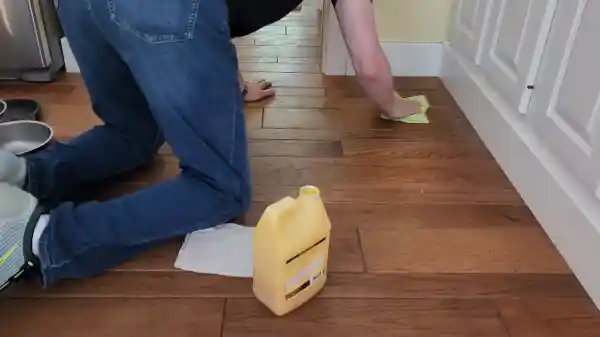
If you have polyurethane-finished hardwood floors and need to clean blood off of them, there are a few key steps to follow.
STEP 1. Wipe the Blood on the Hardwood Floor
First, grab a damp sponge and gently wipe away any spills you see on your beautiful hardwood surface. Make sure to use a clean sponge and avoid rubbing the blood into the wood. Instead, use a light touch and work toward the grain.
If the blood has dried and is difficult to remove, try moistening the area with water before wiping it away.
STEP 2. Rinse and Repeat
After wiping the blood away, keep at it by rinsing the sponge and repeating the process until your hardwood floors are spotless. Ensure all the blood is removed, as leaving even a small amount can lead to staining or discoloration.
To rinse the sponge, run it under cold water until all the blood is washed out. Then, wring it out and continue wiping the floor. Repeat this process until the blood is completely gone.
STEP 3. Wipe the Hardwood Floor
Now it’s time to grab a clean cloth and thoroughly wipe down those beautiful wooden boards. Ensure the cloth is damp but not soaking wet, as excess water can damage the hardwood.
Begin at the edges of the stain and work towards the center, using circular motions to lift any remaining blood residue. Rushing can lead to streaks and missed spots, so take your time.
STEP 4. Dry the Wood Floor
Make sure your beautiful wooden floors are completely dry before you move any furniture back into the area so you don’t risk damaging them. After wiping the floor with a damp cloth or towel, use a dry cloth or towel to soak up any remaining moisture.
Leave the floor to air dry for a few minutes, or use a fan to speed up the process. Avoid using a hair dryer or any other heat source, as it could cause damage to the wood.
What Cleaning Agents can be Used to Clean Blood Stains from Hardwood Floors?
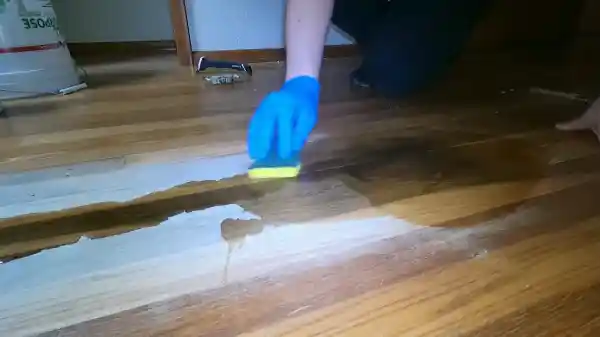
When cleaning blood stains from hardwood floors, there are several cleaning agents you can use:
#1 Baking soda
Using baking soda can be a cost-effective and environmentally-friendly way to eliminate stains and odors from wooden surfaces. Over 90% of households use it as a cleaning agent.
Baking soda is effective at neutralizing odors, so this method can help eliminate any unpleasant smells that may be left behind.
#2 Dish-Washing Detergent
Dish-washing detergent is a powerful cleaner that can cut through stubborn stains and grime. Be sure to rinse the cloth or mop frequently in the solution to avoid spreading the stain. Once the stain is gone, rinse the area with clean water and dry it thoroughly with a clean towel.
#3 White Vinegar
You can easily remove stubborn blood stains from your hardwood floors with white vinegar if you’re tired of struggling with them. You can spray the solution onto the stained area and wait a few minutes.
White vinegar is a great natural solution that can break down the enzymes in the blood and lift the stain from your floors.
#4 Hydrogen Peroxide or Peroxide
You can easily get rid of those pesky stains with hydrogen peroxide. This powerful solution effectively lifts even the toughest stains from your beautiful hardwood surfaces.
Although this is an effective solution, do a test patch on a small, unnoticeable area first to ensure it doesn’t cause any discoloration.
#5 Enzyme-Based Pet Stain Removers
Enzyme-based pet stain removers are a powerful and effective option to consider. These cleaners break down the proteins in pet urine and other organic stains, effectively removing them from your floors. These cleaners are safe for hardwood floors and won’t damage the finish.
#6 Oxygen-Based Cleaners
Oxygen-based cleaners might be the superhero solution to save your surfaces. These cleaners release oxygen to break down and remove stubborn stains, including blood. They’re safe for hardwood floors and can be found in many commercial cleaning products.
How Should Blood Stains on Hardwood Floors be Treated Based on Their Freshness?
When treating blood stains on hardwood floors, the first thing to consider is the freshness of the stain.
- Fresh Blood Stains: If you’re dealing with a recent accident, you’ll want to act fast to prevent any lasting damage to your beautiful hardwood flooring. This includes blot and cleaning with cold water, dishwashing liquid, or baking soda and vinegar.
- Dried blood stains: If you’re dealing with dried blood stains on your wooden floors, you must take a slightly different approach. This includes a steel wool pad (for waxed hardwood), detergent mixture, or enzyme-based cleaners.
Precautions When Cleaning Blood Stains From Hardwood Floors
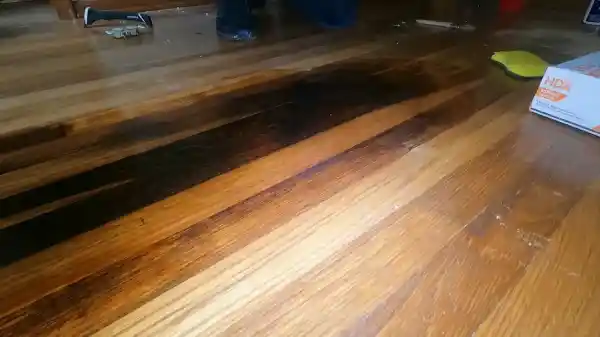
When cleaning blood stains from hardwood floors, take precautions to ensure that you don’t cause any damage. Here are some tips to keep in mind:
- Avoid using harsh chemicals or abrasive materials that could scratch or damage the wood.
- Follow up with a good oiling of the wood after cleaning to restore its natural shine and protect it from future damage.
- Remember to dispose of any contaminated materials properly to avoid spreading the stain or causing further damage.
Can Bleach be Used to Clean Hardwood Floors with Blood Stains?
Using bleach on hardwood floors may cause damage to the finish, so it’s best to consider alternative options. Peroxide is a recommended alternative to bleach. The reason for this is that it effectively dissolves blood stains without harming the surface of the wood.
But if you decide to use bleach, dilute it properly and test it on a small, inconspicuous area before applying it to the entire stain. Remember that the wood may still have residual discoloration even if you remove the blood stain successfully.
Can Leaving a Cleaned Blood Stain Alone Help Reduce Its Visibility?
Allowing the cleaned stain to oxidize naturally may reduce its visibility. After you have done your best to remove the stain, it may be less noticeable if you simply allow it to sit and naturally oxidize.
If the stain is already cleaned up as much as possible, leaving it alone can be an option. But this method may only work for some types of hardwood floors or all types of blood stains.
Don’t Delay, Quickly Clean Blood Stains to Prevent Wood Damage
While it may seem like the blood stain has disappeared, it can seep into the wood and leave a permanent mark over time. So, it’s always best to take action as soon as possible and properly clean the blood stain using our discussed methods.
The key to removing blood stains on hardwood floors is to act quickly and use the right cleaning agents. But before you go, a common theory is that leaving a removed blood stain alone can help reduce its visibility.
With those tips and tricks, you can tackle any blood stain on your hardwood floors. Just remember always to take precautions when cleaning and carefully handle any potentially hazardous cleaning materials.

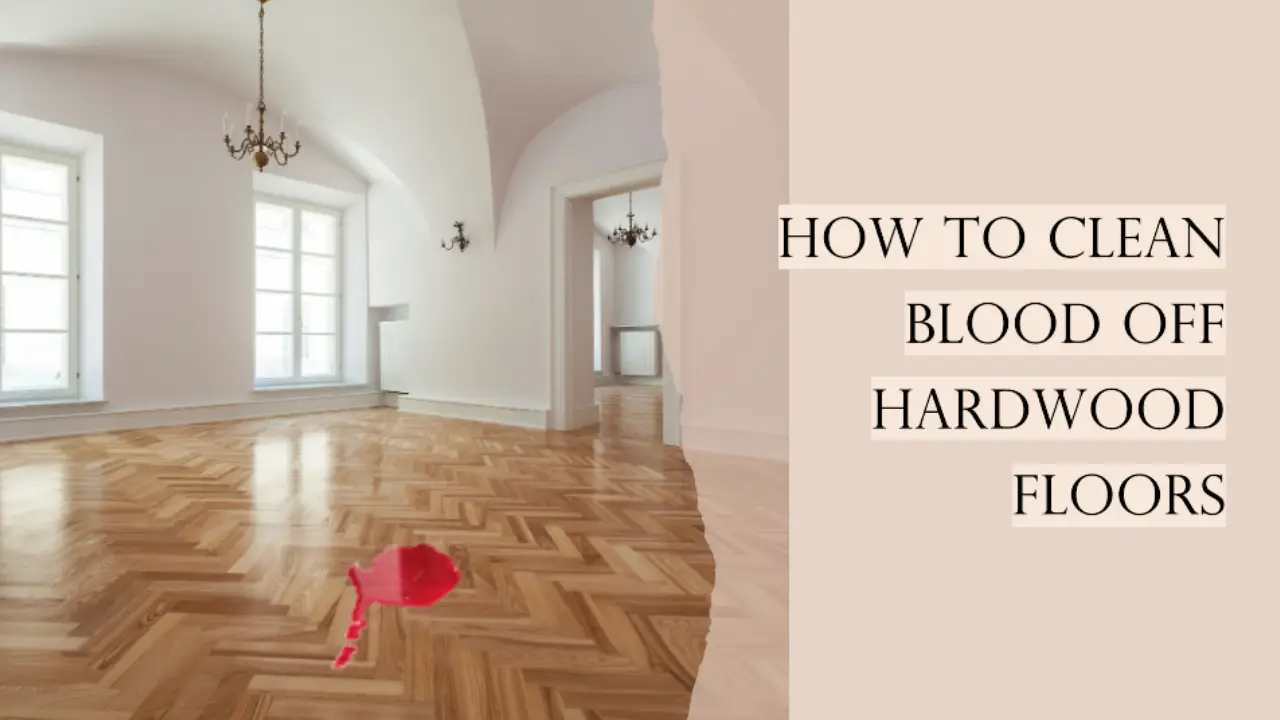

![How to Clean Syrup off Hardwood Floors: 6 Steps [DIY]](https://anyshelter.com/wp-content/uploads/2023/06/How-to-Clean-Syrup-off-Hardwood-Floors.webp)
